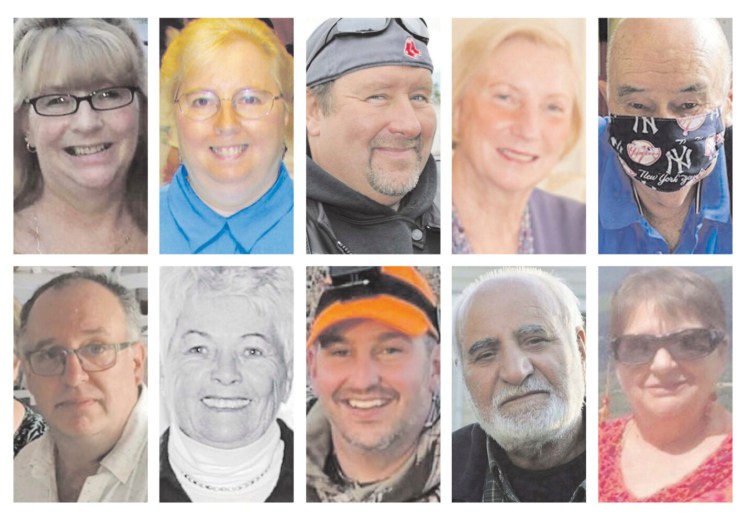They were teachers and musicians, retired firefighters and decorated war veterans, lobstermen, shipbuilders and farmers.
Some were new immigrants to the United States while others descended from Maine’s earliest leaders.
Too many left behind children, grandchildren, great-grandchildren and communities suddenly mourning the loss of a family patriarch or matriarch as the deadly coronavirus inflicted a wildly disproportionate blow on Maine’s oldest citizens.
Maine officially exceeded 1,000 COVID-19 deaths on Tuesday, joining 45 other states that had surpassed that solemn milestone earlier in the pandemic. Although mostly symbolic, Maine’s 1,000th death comes at a time when COVID-19 case rates and hospitalizations are once again surging across the state.
In recent months, Maine’s COVID-19 demographics have shifted dramatically – largely due to the availability of vaccines and high inoculation rates – so that the majority of new coronavirus cases are among people under 40. But throughout the pandemic, COVID-19 has been deadliest among Maine’s oldest citizens.
Roughly 53 percent of all COVID-related deaths, or 535 of the 1,002 reported as of Tuesday, were among Maine residents 80 or older even though they make up just 5 percent of the population. Another 254 deaths, or 25.4 percent, were Mainers in their 70s, while 126 residents in their 60s fell victim to the virus.
Altogether, 915 of Maine’s 1,002 deaths – a staggering 91.3 percent – have been among Mainers 60 or older even though they account for less than 20 percent of all cases to date.
“Those we lost to COVID-19 are people we loved and cherished – parents, grandparents, siblings, children, loved ones and friends, all valued members of our Maine community,” Gov. Janet Mills said in a statement on Tuesday. “We mourn their passing and grieve for the moments they are no longer able to share with us.”
More than one-half of Maine’s deaths occurred between December 2020 and February 2021 as both cases and hospitalizations surged to levels that had not been seen before during the pandemic. The current surge has already surpassed that period for hospitalizations and could eclipse it in terms of caseloads as well.
Statistically speaking, Maine has fared better than almost every other state over the past 18 months.
With 73 deaths for every 100,000 residents, Maine has a lower COVID-19 mortality rate than every state except Vermont, Hawaii and Alaska, according to tracking and analysis by The New York Times. That is roughly one-third the rate for the country as a whole and is four times lower than Mississippi’s nation-leading 311 deaths for every 100,000 residents.
Unsurprisingly, Maine’s two most populous counties account for the largest shares of COVID cases and related deaths. Together, Cumberland and York counties have lost 361 residents to the viral disease, followed by Penobscot County with 132 deaths and Androscoggin with 92.
But some of Maine’s more rural counties have higher per capita death rates, despite being more sparsely populated. In Oxford County, for instance, one out of every 817 residents has died with COVID since March of 2020 while the rate in Aroostook is one out of out every 944 residents.
On the other end of the spectrum, Lincoln County has lost one out of every 8,659 residents – a rate 10 times lower than Oxford County’s – while neighboring Knox County had the state’s second-lowest rate at one death for every 3,977 residents.
Earlier this week, the United States hit another symbolic but historic milestone when COVID-related deaths exceeded the estimated 675,000 deaths caused by the 1918 influenza pandemic nationwide. Maine is still well short, thankfully, of matching the rough estimate of 5,000 dead from the 1918 pandemic.
Yet each of those 1,002 deaths represents a grandparent or parent, an aunt or uncle, a friend or co-worker or neighbor to someone else in Maine. And because of the strict safety precautions implemented in hospitals to limit the spread of the virus, many of those 1,002 people died without people they knew or loved around them.
As a hospital chaplain, the Rev. Shelly Snow has had to offer bedside counsel to people losing the battle against the disease, as well as to family members stuck outside in parking lots or forced to say their farewells over the phone. The experience has been unlike anything Snow expected during her chaplaincy.
“I’m wearing scrubs now when I enter a COVID unit, and hospital chaplains don’t usually wear hospital scrubs,” said Snow, a clinical chaplain for Southern Maine Health Care in Biddeford and Sanford. “I didn’t think I would ever be in the position of facilitating an end-of-life goodbye either virtually or over the phone.”
Snow said she is witnessing “a lot of sadness, people feeling alone, people not able to have those visits with their loved ones.” But she also has seen how the pandemic has reaffirmed the importance of saying “I love you” or “thank you” to each other as well as asking for, or conveying, forgiveness.
And while Snow said she has seen much sadness during the pandemic, she also has seen how the pandemic can lead to positive changes. As one example, Snow recalled getting a visit from someone who was in a “very dire situation” when she last saw them in the COVID unit. Now recovered, the former patient returned to thank her and explain how they were working to rebuild family relationships.
“People are being reminded of what’s important in their lives and are making it happen to the best of their ability,” Snow said.
Send questions/comments to the editors.





Comments are no longer available on this story